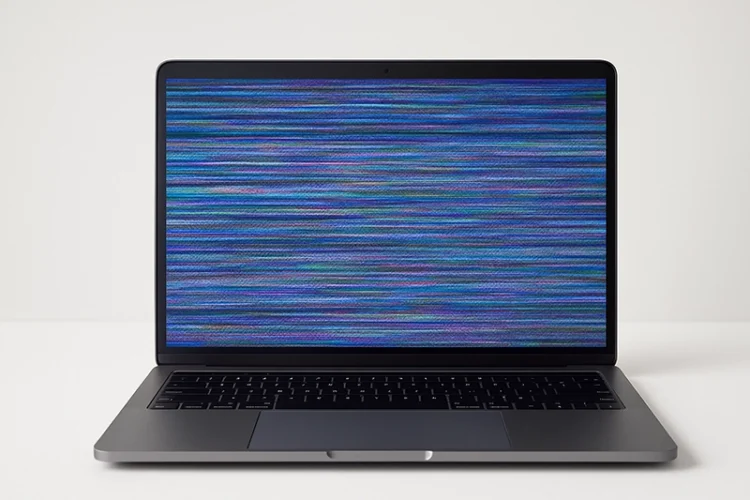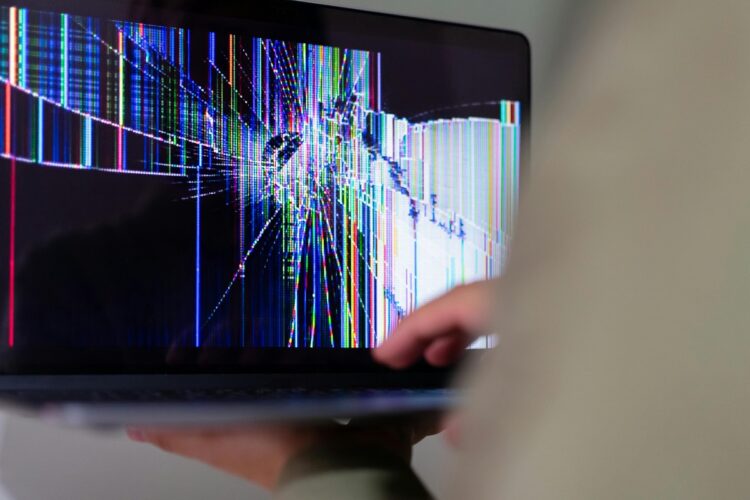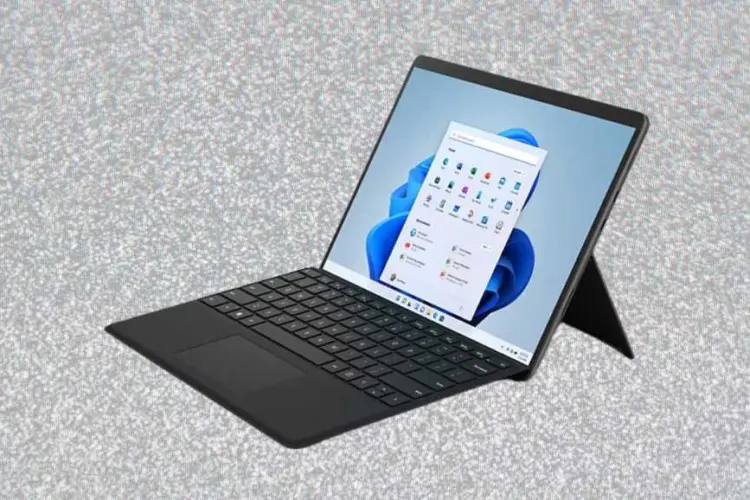
 Diagnosing Common Laptop Screen Problems
Diagnosing Common Laptop Screen Problems
That sinking feeling when your laptop screen glitches or goes dark is familiar to many. One moment you are working, and the next, you are staring at a distorted or blank display. Before you panic, the first step is to identify what exactly is wrong before you send in for a laptop screen repair at Volta PC. Different symptoms point to different underlying issues, and understanding them can help you figure out the next steps.
Here are some of the most common screen problems you might encounter:
- Physical Damage: This is the most obvious culprit. Look closely for cracks on the screen. Sometimes it is a large, spiderweb like fracture, but other times it can be a subtle hairline crack near the edge that is easy to miss. Even a tiny crack can disrupt the entire display, causing large black splotches or colourful lines.
- Display Artefacts: Are you seeing things that should not be there? This includes persistent vertical or horizontal lines, dead pixels that are stuck on black, white, or a single colour, or strange patches of discoloration. These issues often point to a problem with the display panel itself. If you are dealing with lines on your screen, you can learn more about what causes them and how to fix the lines on my laptop screen in our detailed guide.
- Flickering or Black Screens: A screen that flickers intermittently is a common complaint. This is often the first thing people search for when looking for a laptop screen flickering fix. It could signal a failing backlight, a loose internal display cable, or even a graphics card issue. If the screen is completely black but you can hear the laptop running, the problem is almost certainly with the display assembly.
- Backlight Bleeding: This appears as uneven patches of light leaking from the edges of your screen, most visible against a dark background. A small amount of bleed is normal for many LCD screens, but if it becomes distracting and covers large areas, it indicates a fault in the panel.
Simple Checks Before Seeking Professional Help
Once you have an idea of what the problem looks like, there are a few simple checks you can perform yourself. These steps do not require opening your device and can help you rule out software glitches or simple setting issues before you conclude that a hardware repair is necessary. Think of this as a basic health check for your display.
Follow these steps in order:
- Restart and Brightness Check: It sounds almost too simple, but a full reboot can resolve temporary software conflicts that may affect your display. Also, check your keyboard for the brightness control keys. It is surprisingly common for the brightness to have been accidentally turned all the way down, making the screen appear black.
- Update Graphics Drivers: Outdated or corrupt graphics drivers are a frequent cause of screen flickering, artefacts, and other display anomalies. For Windows users, you can check for updates in the Device Manager. On a Mac, driver updates are typically included with macOS updates, which you can find in System Settings.
- The External Monitor Test: This is the most definitive test you can do at home. Connect your laptop to an external monitor or a TV using an HDMI or USB C cable. If the external display works perfectly, the problem is isolated to your laptop’s screen or its connecting cable. If the external display shows the same flickering or distortion, the issue likely lies with your graphics card.
- Inspect Physical Connections: Gently inspect the hinge area of your laptop. Can you see any frayed or pinched cables? While this can indicate a loose connection, do not attempt to open the laptop casing yourself. Modern laptops have delicate connectors that are easily damaged. If you suspect a hardware issue, this is the point where a professional should take over. We can explain how it works when you bring your device in for a diagnosis.
The Professional Laptop Screen Repair Process
If the simple checks did not solve the problem, it is time to consider professional help. Entrusting your device to an expert ensures the job is done correctly and safely. A reputable repair service follows a structured process designed to provide clarity, quality, and peace of mind. It is more than just swapping a part; it is a meticulous procedure.
Here is what you can expect from a professional laptop screen repair Singapore service:
- Initial Assessment and Quotation: The process begins with a thorough diagnosis to confirm the fault. A technician will verify whether the issue is the screen, the cable, or the graphics card. Afterwards, a trustworthy service in Singapore will provide a clear, no obligation quote that details the cost of the replacement part and labour.
- Sourcing the Correct Replacement Part: Using the right part is critical. Professionals have access to high quality, compatible screens for all major brands like Apple, HP, and Lenovo. For a specific job like a Dell laptop screen repair, they will source a panel that matches the original’s specifications for size, resolution, and connector type, ensuring a perfect fit and flawless performance.
- Meticulous Disassembly and Installation: This step requires significant technical skill. The technician will carefully disconnect the power, remove the screen’s plastic bezel, detach the damaged panel, and install the new one. This is done with precision to avoid damaging other sensitive components like the webcam, Wi Fi antennas, or the motherboard.
- Final Testing and Quality Assurance: After the new screen is installed, the job is not finished. A thorough testing phase begins. Technicians check for dead pixels, ensure colour accuracy and uniform brightness, and verify that features like touchscreens or automatic brightness adjustments are fully functional. This commitment to quality is what leads to positive customer reviews and a reliable repair.
Understanding Repair Costs and Timelines in Singapore
Two of the biggest questions on anyone’s mind are “How much will this cost?” and “How long will it take?” The answers depend on several factors, but a transparent repair service should be able to give you a clear estimate upfront. Understanding these variables helps you set realistic expectations.
The cost to fix cracked laptop screen is influenced by the laptop’s brand and model, screen size, resolution (HD vs. 4K), and technology (LCD, OLED, or touchscreen). For example, the MacBook screen replacement cost is typically higher because the display is an integrated assembly that includes the metal lid, making the part itself more expensive. In contrast, a standard non touch screen for an Acer or Lenovo laptop is more affordable.
Turnaround time in Singapore is often quite fast for common models. If the replacement part is in stock, many repairs can be completed on the same day or within 24 hours. For specialised screens, such as those for high end gaming laptops or less common models, the part may need to be ordered, which can extend the timeline. Finally, always ask about a warranty. A reputable service will stand by their work with a warranty on the new part and their labour, giving you confidence in your investment.
| Laptop Category | Estimated Cost (SGD) | Typical Turnaround Time |
|---|---|---|
| Standard Non Touch (e.g., Acer, Lenovo HD) | $145 – $350 | Same Day – 24 Hours |
| Premium / Touchscreen (e.g., Dell XPS, HP Spectre) | $350 – $650 | 1 – 3 Business Days |
| MacBook (Air / Pro) | $450 – $900+ | 1 – 4 Business Days |
| Gaming Laptops (High Refresh Rate) | $400 – $800+ | 2 – 5 Business Days (Parts may need ordering) |
Note: These are estimated prices and can vary based on the specific model, part availability, and the complexity of the repair. Always request a precise quote from your service provider.
Choosing a Trustworthy Repair Service Over DIY
When faced with a broken screen, the temptation to order a cheap part online and attempt a DIY repair can be strong. However, this path is filled with risks that can lead to more expensive problems. Modern laptops are not designed for easy user repair, and a single mistake can be costly.
Consider these points before you reach for a screwdriver:
- The Dangers of DIY: It is incredibly easy to crack the new screen during installation, damage the fragile ribbon cable connectors, or accidentally cause a short circuit that could destroy your laptop’s motherboard. What started as a screen issue could become a total device failure.
- The Problem with Counterfeit Parts: Those low cost screens on online marketplaces are often low quality counterfeits. They may suffer from poor colour accuracy, low brightness, and a much shorter lifespan. You may save money initially only to need another replacement soon after.
- The Value of Professional Expertise: A reliable computer repair Singapore service has the correct tools, anti static equipment, and experience to handle complex devices. Technicians know how to work around glued in components and have the expertise for specific models, such as providing a dedicated ASUS laptop repair service.
Ultimately, investing in a professional repair is the most sensible choice for your device’s health and your own peace of mind. A service like Volta PC Upgrade & Repair ensures the job is done right with a quality part and a warranty, protecting your investment and getting you back to work without the added stress.
Related Repair Services in Singapore
Laptop Screen Repair • HP Laptop Screen Replacement • Asus Laptop Screen Repair





